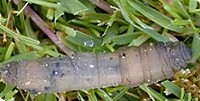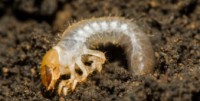Pests
Leather Jackets
 These are the grubs of the common crane fly or “daddy long legs”
These are the grubs of the common crane fly or “daddy long legs”
They cause severe damage to turf areas over the autumn to spring period when they are feeding on the grass roots. The effects are most noticeable during dry spring weather when the turf starts to die off due to an inadequate root mass, which cannot provide adequate water and nutrients to the plant.
There are several signs that indicate the presence of leather jackets;
- A large number of adult crane flies in July and August
- Rooks, Crows and Starlings feeding on the lawn
- Bare patches appearing in the grass
- Yellow patches in early spring
If you think you have an infestation of Leatherjackets contact Lawn3 who will assess the problem and where necessary apply a contact insecticide to control the larvae numbers and the resulting damage.
Chafer grubs
 Chafer grubs are the larvae of the chafer beetle. They cause problems on lawns by feeding on the roots of grass plants.
Chafer grubs are the larvae of the chafer beetle. They cause problems on lawns by feeding on the roots of grass plants.
The adults appear between May and July depending on the weather conditions in spring, they feed on shrubs and trees before laying the eggs in the grass.
Larvae hatch about 2 weeks later and begin to feed on grass roots until late September when they move deeper into the soil where they pass the winter. The larvae have white bodies curved in letter C shape, light brown heads, with 3 pairs of legs.
As the larvae grow bigger, they cause more damage. Early symptoms include gradual thinning, yellowing and weakening of the grass where the roots have been damaged followed by the appearance of irregular dead patches. In most cases the larvae are discovered when birds or mammals begin to rip up areas of the turf looking for the grubs.
If you think you have an infestation of Chafer Grubs contact Lawn3 who will assess the problem and where necessary apply a contact insecticide to control the larvae numbers and the resulting damage.



